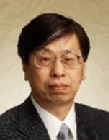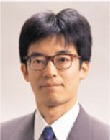 |
 |
 |
Professor |
Assistant Professor |
Research Associate |
|
First and foremost, the Image Processing Laboratory engages in research and development
of image-based pattern recognition including some areas of Artificial Intelligence,
database organisation, retrieval, and robotics. More specifically, as can be seen from the
background information and the recent research publications of the members of the
laboratory, 2-dimensional Continuous Dynamic Programming for non-linear image registration
without mode, object tracking in a time-varying image, image retrieval from
video data, character recognition of telop in a video image and extracion of the Internet
community are our current focus. Related to the recent progress of the web, a huge amount of multimedia data without index becomes available to store in our PC's. However, no sophistcated methodology to manage such data has been developed so far. So that we are solicited to attach an index to each data. Our research aim is to develop algorithms to realize automatic annotation to real word data for integrated retrieval of multimedia information. The algorithms include self-organisation and transformation among representation of multimedia and feature extraction and recognition of real data. Real world data includes video, still image, speech, music, sound, and text each of which has not been indexed by labels. An example of multimedia integration retrieval called "CrossMediator" developed by ten-year project (1992-2002) RWC of METI (Japan). Some parts of CrossMediator have been in the commercial market by through a private company. Prof. R. Oka was a chief of group which developed "CrossMediator". Our laboratory will pursue to develop more sophisticated functions which might reveal a new generation of the Internet. Speech retreival system used in CrossMediator is used for developing new types of commercial products. At the present time we use two kinds of index for searching video data. One is used to obtain the target media from Youtube by using index. The other one is used for searching parts of the target data which are not indexed. One of the recent progress is developing a set of algorithms for spotting recognition and tracking objects in a time-varying image. These algorithms enable to realize automatic anonotation of video image capturing moving objects. The most promissing algorithm called 2-dimensional Continuous Dynamic programming (2DCDP) was proposed by our laboratory. This enables to perform full pixel matching between images. The full pixel correspondene is used for reconstructing 3D shape from at least 3 images obtained from different viewpoints and also gives a quite precise features like optical flow from a motion image. The 2DCDP is also applicable to non-linear registration for medical images to extract different parts between normal CT imagesand abnormal CT images. Another recent progress is developing a spotting algorithm for song wave retrieval. A large amount of song wave data is available for anyone along with the progress of storage hardware of music data. But the progress of technology for accessing the song wave data seems quite slow so that we must use conventional and not sophistcated tools. Our new software can provide users a convenient way to find and rerieve the song wave data by singing an arbitrary part of it which he/she wants to hear. The Internet is regarded as a network composed of virtual communities. Visualization of the community is becoming an important research target. Our lab is developing a sophistcated algorithm based on so-called Associated hyper-linked word space (A-space). We use the algorithm to detect clusters each of which corresponds a virtual community. Visualization of each virtual community is realized by showing the content extracted from the web pages included the community. On the other hand, we have carried out several research projects related to complex systems in which many independent components interact with each other and emerge global phenomena. Particularly, we have conducted on multiple robot control, full body motion generation in a humanoid, and analysis of human communication in the web space. With respect to multiple robot control, we have analyzed the dynamics of multiple mobile robots as a swarm under the mixture condition of long and short range communication, and evaluated the required amount of communication for the multiple robot control. With the analysis results, we have developed a control method of multiple mobile robots as a swarm. As implementing actual multiple mobile robots, we need a sensing system. In this project, we have developed a sensing and position estimating system for the robots. In terms of the full body motion generation in a humanoid, we have developed a method inspired from the mature gait, which is the change of walking pattern in human when growing from an infant through a child to an adult. For the analysis human communication in the web space, we have modeled a process of posting a message to the web space, and verified it with a large amount of actual web logs. Also, utilizing results drawing from the model, we have developed a new recommendation system considering both local interaction among users and emerged global phenomena. |
Refereed Proceeding Papers
| [oka-01:2008] |
Yuuichi Yaguchi, Kenta Iseki, and Ryuichi Oka. Optimal Pixel Matching
between Images. In Proc. of PSIVT2009, pages 597–610. LNCS, January
2009. |
|
A two-dimensional continuous dynamic programming (2DCDP) method is proposed
for two-dimensional spotting recognition of images. Spotting recognition is simultaneous
segmentation and recognition of an image by optimal pixel matching between
a reference and an input image. The proposed method performs optimal pixel-wise
image matching and two-dimensional pixel alignment, which are not available in
conventional algorithms. Experimental results show that 2DCDP precisely matches
the pixels of non-linearly deformed images. |
|
| [oka-02:2008] |
Yuichi YAGUCHI, Kenta ISEKI, and Ryuichi OKA. Two-dimensional
Continuous Dynamic Programming for Spotting Recognition of Image. In
Proceedings of meeting on Image Recognition and Understanding, pages 707–
714. IEICE, July. 2008. |
|
An algorithm called 2DCDP is proposed for realizing two-dimensional spotting
recognition of image. Spotting recognition means the simultaneously realization
of both segmentation and recognition of image by means of optimal pixel correspondence
between a reference image and an input image. The proposed algorithm
performs completely the optimally pixel-wise image matching and two-dimensional
pixel alignment which are not guaranteed by previous ones. Our experimental results
show that 2DCDP performs highly precise pixel matching for non-linearly deformed
images. |
|
| [oka-03:2008] |
Hisato AOTA, Yuichi YAGUCHI, Ryuichi OKA, and Hiroki MIZOE. Extraction
of Motion Features for Monitoring Accidents of Electrical Feeder
Lines. In Proceedings of meeting on Image Recognition and Understanding,
pages 885–890. IEICE, July. 2008. |
|
To detect and observe the location and angle of electrical feeder lines in galloping
movies, the observer must recognize the relation of two red balls acting as spacers
for pairs of lines. This research proposes and develops a system to detect these balls
using color recognition in image processing. Our experiments, show that this system
is successful in finding feeder lines and recognizing the angles of the lines for almost
all cases. Additionally, the system has the advantage that it can interpolate for
missed frames during recognition. However, some movies have color problems. |
|
| [oka-04:2008] |
Hisato Aota, Yuichi Yaguchi, and Ryuichi Oka. Feature Detection of Electrical
Feeder Lines with Galloping Motion. In Proceedings of 2008 Computer
and Information Technology, pages 583–588. IEEE, July. 2008. |
|
To detect and observe the location and angle of electrical feeder lines in galloping
movies, the observer must recog-nize the relation of two red balls acting as spacers
for pairs of lines. This research proposes and develops a system to detect these balls
using color recognition in image processing. Our experiments, show that this system
is successful in finding feeder lines and recognizing the angles of the lines for almost
all cases. Additionally, the system has the advantage that it can interpolate for
missed frames during recognition. However, some movies have color problems. |
|
| [oka-05:2008] |
Yuichi Yaguchi, Keitaro Naruse, and Ryuichi Oka. Fast Spotter: An Approximation
Algorithm for Continuous Dynamic Programming. In Proceedings
of 2008 Computer and Information Technology, pages 583–588. IEEE,
July. 2008. |
|
Spotting recognition is a simultaneously realization of both recognition and segmentation.
It is able to extract suitable information by query from input data set, and it
is developed as a research topic called word spotting using dynamic programming or
HMM. Continuous Dynamic Programming (CDP) is a promising method for spotting
recognition applied to a sequential pattern. However, calculation burden for
conducting a retrieval task using CDP increases by the order of O(n2), where n
is the size of query frames and m is the size of input frames. This paper proposes
faster non-linear spotting method like CDP, called fast spotter (FS). FS is regarded
as an approximation method of CDP using a function of A* search. FS can reduce
calculation burden with the size O(n log2 n) in best case and around 1/2 in time at
experimental data, and it enables to realize a large-scale speech retrieval system. |
Unrefereed Papers
| [naruse-01:2008] |
Keigo Suenaga, Keitaro Naruse, and Masao Kubo. Control of multiagent
swarm by Boids model. In Proceedings of JSME Robotics and Mechatronics
Conference 2008, 2008. |
| [naruse-02:2008] |
Shota Suzuki, Keitaro Naruse, and Masao Kubo. Analysis of Social
Interactive Communication In Web BBS. In Proceedings of 18th Intelligent
System Symposium, 2008. |
| [naruse-03:2008] |
IKeitaro Naruse, Masao Kubo, Hiroshi Sato, and Takashi Matsubara.
Understanding Emergent Behaviors of Posting Activities on Web Bulletin
Board System. In IPSJ SIG Technical Report 2008-MPS-71, 2008. |
| [naruse-04:2008] |
Keitaro Naruse, Masao Kubo, Hiroshi Sato, and Takashi Matsubara.
Population Estimation of Anonymous Online Forum Community by Posted
Article Distribution. In IPSJ SIG Technical Report 2008-MPS-71, 2008. |
| [naruse-05:2008] |
Keitaro Naruse. Localication System for Mobile Robots with Simultenious
Multiple Landmarks. In Proceesing of SICE System Integration
Division Conference 2008, 2008. |
| [naruse-06:2008] |
Masao Kubo and Keitaro Naruse. Understanding Communication by
SIR Model. In Proceesing of SICE System Integration Division Conference
2008, 2008. |
| [naruse-07:2008] |
Shingo Mizoi and Keitaro Naruse. Sideway Sway by Ankle Compliance
in Evorutionary Bipedal Walking. In JSPE Conference 2009 Spring, 2009. |
| [naruse-08:2008] |
Taku Ohashi and Keitaro Naruse. Recommendation System by User
Evaluation Degrees. In JSPE Conference 2009 Spring, 2009. |
| [oka-06:2008] |
Kenta ISEKI, Yuichi YAGUCHI, Kazuhiro OTA, Masato CHIBA, and
Ryuichi OKA. System for 3D Shape Reconstruction of Castellation from
Moving Camera Images. In Technical Report of PRMU2008-165, pages
105–110. IEICE, December 2008. |
| We realized a system of reconstructing 3D shape effectively from images by using
2-dimentional continuouse dynamic programming(2DCDP) and factorization
method. 2DCDP provides non-linear optimal pixel matching calculation for images.
Therefore, we can create input matrix for factorization method by using 2DCDP
from a reference image and other few images instead of measuring a target with
special instruments or estimating camera paramater beforehand. However, there
are several problems about calculation speed and memory size for the reason that
the order of 2DCDP is O(N4). In this paper, we dealt effectively with that problems
by parallel inplementation of 2DCDP and its calculation machine. Besides of
that, we proposed a system that integrate partial 3D shapes deriverd from devided
reference image with a mosaicked shape when the images are leratively large. In
the experiment, we indicate that proposed method worked well for reconstructing
3D shape of Castellation as a sample case. |
|
| [oka-07:2008] |
Kenta ISEKI, Yuichi YAGUCHI, and Ryuich OKA. 3D Shape Reconstruction
Using Optimal Pixel Matching Between Images. In Technical Report
of CVIM1, pages 101–108. IEICE, November 2008. |
| We propose a method for reconstructing a 3D shape using optimal pixel matching
data between images obtained by so-called 2-dimensional Continuous Dynamic
Programing(2DCDP). Conventional methods used a sequence of matching feature
points obtained from a sequence of of motion image. Our proposed method uses
corresponding data of all pixels between a selected image and any other image
belonging to the rest of image data. The dense pixel matching data enables to
reconstruct 3D shape using only a small number of images when we apply factorization
method to the data. The mesh structure is directly obtained by using all
pixel matching data o fall pixels, therefore we do not use delaunay triangle mesh to
make the texture map on the 3D surface. We conducted the experiments to show
the fine reconstruction of 3D shape by a small number of images and also the experiments
to compare the result of our method with that of a typical conventional
method (SIFT tracking or KLT method and factorization) using the same image
data. These results shows that our proposed method is superior to the conventional
method. |
|
| [oka-08:2008] |
Hisato Aota, Kenta ISEKI, Yuichi YAGUCHI, and Ryuich OKA. Extracting
Motion Features from Full Pixel Correspondence Between Images
Using two-dimensional Continuous Dynamic Programming. In Proc. of 2009
Workshop on Dynamic Image Processing for Real Application, pages 194–
198. The Japan Society for Precision Engineering, March 2009. |
| We propose a method for extracting motion features. The features are obtained by
integrating full pixel correspondence between images of video stream. The optimal
pixel matching data between images obtained by so-called 2-dimensional Continuous
Dynamic Programing(2DCDP). The features are used for recognizing human
movements like gesture etc. |
Academic Activities
| [oka-17:2008] |
Ryuichi Oka, May 2008. Reviewer of submitted papers, the Acoustic Society of Japan |
| [oka-18:2008] |
Ryuichi Oka, May 2008. Reviewer of submitted papers, the Institute of Electronics, Information and Communication Engineers |
| [oka-19:2008] |
Ryuichi Oka, April 2008. Senior Member of editorial committee, Japanese Society for Artificial Intelligence |
| [oka-20:2008] |
Ryuichi Oka, April 2008. Reviwer of submitted papers, the eighth Inter. Conf. on Computer and Information Technology |
Others
| [oka-21:2008] |
Ryuichi Oka, Yuichi Yaguchi, and Kenta Iseki. Application of Japanese patent titled Image pattern matching device, and method and program, Tokugan-2009-5682, 2009, 14-th, January, 2009 |
